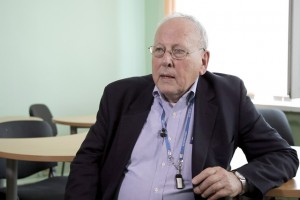End of Knowledge
Philosopher and sociologist of science Steve Fuller on the difference between ontology and epistemology, trans...
So the question arises: what is a global technography? I will begin with an imperative, that as long as technology continues to be treated as an intruder into our everyday lives, rather than recognized as inseparably part of that, our understanding of the world is going to be flawed and sometimes that could be dangerous. Most of what I have worked at has not been terribly dangerous for humanity, but we can actually extrapolate and find many instances in which technology breakdown or interaction with technology has led to disastrous consequences.
The theoretical grounding for global technography is rooted in James Carey’s ritual model of communication, and in particular his description, that we need to pay attention to the creation, the apprehension and the use of our symbols. So, for James Carey the world is a complex set of interactions, in which the individual is taught a symbolic order by society, then goes out into the world and both recognizes that use of the symbolic as a material practice and engages in it themselves, then goes back to join society and teach others of the very same symbolic order. It also includes actor-network theory as an important element, because it recognizes that technology is socially acted, that the technology is not a benign material that just sits there, it actually acts socially with us every day in our everyday encounters.
It also draws from Heidegger’s philosophy of technology, which recognizes that humans are the engines of technology.
We are the ones who drive technology forward far from this dystopian idea, that machines are somehow driving themselves, we are actually the ones that push technology forward.
It also addresses Peter Lunenfield’s issue with digital dialectics. And Lunenfeld brought up the issue that determinism demarcates some answers as off limits, and we need to get past these entrenched positions. In this case, we can think about how we actually deal with technology in our everyday encounters. Some answers have been put off limits categorically before we even asked the question, and so Lunenfeld is saying, we need to get past that in order to really understand how we are using the stuff.
Global technography draws from several methodological principles. There is an interpretive ethnography described by Norman Denzin, in which he distinguishes between what he calls authentic and spurious understanding. So, a spurious understanding is to be able to describe something phenomenologically, here is what happened or here is what looks like happened, but an authentic understanding would actually draw in the audience so that they might have some sense of what the experience of that phenomenon actually was, what it was like to be there.
It also uses transcendental phenomenology and looks at how the phenomenon is meaningful for the people involved and methodologically uses autoethnography. This is, in particular, the way that Bochner analyses describe it, that the researcher is situated within the study and contends with the issues of objectification within the text. And again drawing from Norman Denzin’s work, it uses performance ethnography, which focuses on the effects of social performativity, rather than causality. So, there are, according to Denzin, part of this mandate is to have radical utopian imaginings, how could things have been different. And this is important, because if we want to change behavior we have to have some sense of how we might behave otherwise.
The observational focus is on the eruptions of technological performances. And this is to actually focus on the alliances of humans with technology, so when and where these eruptions happened is where the documentation takes place. The goal is documenting these experiences of mobility. Now it is worth mentioning that this work was done a decade ago at this point, and this is a time when mobility, in particular, global mobility was a new thing. So looking back on it now we can say, well, some of this seems pretty straightforward, but at the time it was very new stuff. So, an example of what this looks like now in the present: just the other day, when I arrived in Moscow, I was looking at my phone and commented that something was happening in California, and that would have been a very strange comment just ten or fifteen years ago, now it seems like a very commonplace phrase.
So, what this means, not that this is over, this inquiry, but actually it is moved on to a different set of concerns at this point, which I am going to elaborate a little bit later. The early discoveries, that we are supported by this kind of research were broken into categories of mobility, materialities, and imaginaries. In terms of mobility, the discovery was, this relationship to infrastructure, that global mobility depends on the extent of the network in that sense, and so, even though it is a fluid kind of relationship within the network, the extent of the networks to some degree still defines how mobile we can be.
It is also proportional to what we might consider old-world hierarchies. That participation in the system entails conformity. For example, most of our electronic equipment is actually programmed in English, so this is an old world hierarchy, that entails the conformity on the technical level. But we can also, as a result, take home with us, we can reproduce many of our practices, that we would at home, in other places, and so, the definition of home or what we think of this changes a little bit. We no longer have to be physically present in order to remain attached to our home network.
There is also an artefactual appropriation, that works strategically and it is not one way. We are actually grasping these artifacts in a strategic way, informed by a logic that makes sense to us, but at the same time, these objects are also conveying logic to us. In terms of imaginaries, global technography discovered that mobility enables a new means of imagining performance, and stabilizing our identities, for example, nationalism. It is because of this new means of imagining the self, that someone like myself, who has not lived in Canada since 2002, can still consider myself very Canadian, I still know what is going on there, whereas a couple of decades ago it would have been very difficult for somebody to still imagining themselves as an active or participating citizen, when living abroad for so long.
But technologically in the past decade, what has changed, is an intensification of technological mobility. Our smartphone, the tablets, the GPS guidance, things like this that, that we now carry with us, have converged to such an extent, that the technological experience has transcended the idea of having to carry objects around.
Things like the Apple watch, for example, have attempted to make this as much a part of our body or fashion choices as putting on a tie.
We also have new artefactual and performative materialities, these are different hardwares, softwares, and programmatic imaginations, so, we have seen experiments with things like Google glass, but we are also getting things like virtual reality visors very soon coming to market in a mass production way, and this is all very new, it is a game-changing type of technology as we immerse more and more into the virtual experience.
We also have these new imaginaries, that the technological dependence on our ontological security is intensifying, and what this means is that there is a conceptual collapse of virtual and physical space, so, as I mentioned with the virtual reality visors, we are no longer able to distinguish so easily between, what is a virtual experience and what is a physical world experience, especially, when we bring in a haptic feedback, so it feels like we are actually physically encountering things.
And sociopolitically we have an extreme portability of information and intensified instantaneity: there is almost no delay from one part of the globe to another anymore. This has made mobility seem like a common-sense, commonplace experience. Materially, we have had the global financial crisis and global financial empire oscillations, that really show how we, as a global community, are tied together. There is been the commodification of genetics, there is been an ongoing deployment of an array of authority, and we have new forms of appropriating labor, that depend on this kind of mobility. We also have unprecedented stratification, and this is reflected in the space of flows, that only certain things go certain directions. And we also have the rise of social networking as a mass media format, this turns any individual into a potential mass broadcaster, this brings with it also disproportional effects, that any person within the network can cause a ripple to go through the entire network, and at times it has caused crisis, at times it has caused sensationalism, and often it has caused quite a lot of absurdity.

Philosopher and sociologist of science Steve Fuller on the difference between ontology and epistemology, trans...

Philosopher David Schmidtz on ethical dilemmas, moral institutions, and the nature of justice

MIT Prof. Loren Graham on biomedical ethics, challenges of becoming an academic discipline, and the impact of ...